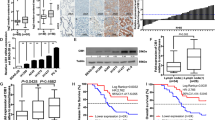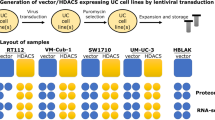Abstract
Cadmium (Cd), a highly toxic heavy metal, is widespreadly distributed in the environment. Chronic exposure to Cd is associated with the development of several diseases including cancers. Over the decade, many researches have been carried on various models to examine the acute effects of Cd; yet, limited knowledge is known about the long-term Cd exposure, especially in the human lung cells. Previously, we showed that chronic Cd-exposed human bronchial epithelial BEAS-2B cells exhibited transformed cell properties, such as anchorage-independent growth, augmented cell migration, and epithelial–mesenchymal transition (EMT). To study these Cd-transformed cells more comprehensively, here, we further characterized their subproteomes. Overall, a total of 63 differentially expressed proteins between Cd-transformed and passage-matched control cells among the five subcellular fractions (cytoplasmic, membrane, nuclear-soluble, chromatin-bound, and cytoskeletal) were identified by mass spectrometric analysis and database searching. Interestingly, we found that the thiol protease ubiquitin carboxyl-terminal hydrolase isozyme L1 (UCHL1) is one of the severely downregulated proteins in the Cd-transformed cells. Notably, the EMT phenotype of Cd-transformed cells can be suppressed by forced ectopic expression of UCHL1, suggesting UCHL1 as a crucial modulator in the maintenance of the proper differentiation status in lung epithelial cells. Since EMT is considered as a critical step during malignant cell transformation, finding novel cellular targets that can antagonize this transition may lead to more efficient strategies to inhibit cancer development. Our data report for the first time that UCHL1 may play a function in the suppression of EMT in Cd-transformed human lung epithelial cells, indicating that UCHL1 might be a new therapeutic target for chronic Cd-induced carcinogenesis.

Graphical abstract







Similar content being viewed by others
References
Abdelmaksoud-Dammak R, Saadallah-Kallel A, Miladi-Abdennadher I, Ayedi L, Khabir A, Sallemi-Boudawara T, et al. CpG methylation of ubiquitin carboxyl-terminal hydrolase 1 (UCHL1) and P53 mutation pattern in sporadic colorectal cancer. Tumour Biol. 2016;37(2):1707–14.
Ganguly K, Levanen B, Palmberg L, Akesson A, Linden A. Cadmium in tobacco smokers: a neglected link to lung disease? Eur Respir Rev. 2018;27(147):170122.
Gao Y, Xu Y, Wu D, Yu F, Yang L, Yao Y, et al. Progressive silencing of the zinc transporter Zip8 (Slc39a8) in chronic cadmium-exposed lung epithelial cells. Acta Biochim Biophys Sin. 2017;49(5):444–9.
International Agency for Research on Cancer. IARC monographs on the evaluation of the carcinogenic risks to humans: beryllium, cadmium, mercury, and exposures in the glass manufacturing industry. IARC. 1993;58:119–238.
Jin C, Yu W, Lou X, Zhou F, Han X, Zhao N, et al. UCHL1 is a putative tumor suppressor in ovarian cancer cells and contributes to cisplatin resistance. J Cancer. 2013;4(8):662–70.
Kagara I, Enokida H, Kawakami K, Matsuda R, Toki K, Nishimura H, et al. CpG hypermethylation of the UCHL1 gene promoter is associated with pathogenesis and poor prognosis in renal cell carcinoma. J Urol. 2008;180(1):343–51.
Kawasaki T, Kono K, Dote T, Usuda K, Shimizu H, Dote E. Markers of cadmium exposure in workers in a cadmium pigment factory after changes in the exposure conditions. Toxicol Ind Health. 2004;20(1-5):51–6.
Kim HS, Kim YJ, Seo YR. An overview of carcinogenic heavy metal: molecular toxicity mechanism and prevention. J Cancer Prev. 2015;20(4):232–40.
Kirschvink N, Martin N, Fievez L, Smith L, Marlin D, Gustin P. Airway inflammation in cadmium-exposed rats is associated with pulmonary oxidative stress and emphysema. Free Radic Res. 2006;40(3):241–50.
Lau ATY, Chiu JF. The possible role of cytokeratin 8 in cadmium-induced adaptation and carcinogenesis. Cancer Res. 2007;67(5):2107–13.
Lee YH, Tan HT, Chung MC. Subcellular fractionation methods and strategies for proteomics. Proteomics. 2010;10(22):3935–56.
Li L, Tao Q, Jin H, van Hasselt A, Poon FF, Wang X, et al. The tumor suppressor UCHL1 forms a complex with p53/MDM2/ARF to promote p53 signaling and is frequently silenced in nasopharyngeal carcinoma. Clin Cancer Res. 2010;16(11):2949–58.
Liang ZL, Wu DD, Yao Y, Yu FY, Yang L, Tan HW, et al. Epiproteome profiling of cadmium-transformed human bronchial epithelial cells by quantitative histone post-translational modification-enzyme-linked immunosorbent assay. J Appl Toxicol. 2018;38(6):888–95.
Liu SJ, Gonzalez-Prieto R, Zhang MD, Geurink PP, Kooij R, Iyengar PV, et al. Deubiquitinase activity profiling identifies UCHL1 as a Candidate oncoprotein that promotes tgf beta-induced breast cancer metastasis. Clin Cancer Res. 2020;26(6):1460–73.
Livak KJ, Schmittgen TD. Analysis of relative gene expression data using real-time quantitative PCR and the 2-ΔΔCT Method. Methods. 2001;25:402–8.
Mandelker DL, Yamashita K, Tokumaru Y, Mimori K, Howard DL, Tanaka Y, et al. PGP9.5 promoter methylation is an independent prognostic factor for esophageal squamous cell carcinoma. Cancer Res. 2005;65(11):4963–8.
Nair AR, DeGheselle O, Smeets K, Van Kerkhove E, Cuypers A. Cadmium-Induced pathologies: where is the oxidative balance lost (or not)? Int J Mol Sci. 2013;14(3):6116–43.
Okochi-Takada E, Nakazawa K, Wakabayashi M, Mori A, Ichimura S, Yasugi T, et al. Silencing of the UCHL1 gene in human colorectal and ovarian cancers. Int J Cancer. 2006;119(6):1338–44.
Satarug S, Moore MR. Adverse health effects of chronic exposure to low-level cadmium in foodstuffs and cigarette smoke. Environ Health Perspect. 2004;112(10):1099–103.
Scherer G, Barkemeyer H. Cadmium concentrations in tobacco and tobacco smoke. Ecotoxicol Environ Saf. 1983;7(1):71–8.
Tan HW, Xu YM, Wu DD, Lau ATY. Recent insights into human bronchial proteomics - how are we progressing and what is next? Expert Rev Proteomics. 2018;15(2):113–30.
Tan HW, Liang ZL, Yao Y, Wu DD, Mo HY, Gu J, et al. Lasting DNA damage and aberrant DNA repair gene expression profile are associated with post-chronic cadmium exposure in human bronchial epithelial cells. Cells. 2019;8(8):842.
Tian F, Yip SP, Kwong DL, Lin Z, Yang Z, Wu VW. Promoter hypermethylation of tumor suppressor genes in serum as potential biomarker for the diagnosis of nasopharyngeal carcinoma. Cancer Epidemiol. 2013;37(5):708–13.
Tokumaru Y, Yamashita K, Kim MS, Park HL, Osada M, Mori M, et al. The role of PGP9.5 as a tumor suppressor gene in human cancer. Int J Cancer. 2008;123(4):753–9.
Ummanni R, Jost E, Braig M, Lohmann F, Mundt F, Barett C, et al. Ubiquitin carboxyl-terminal hydrolase 1 (UCHL1) is a potential tumour suppressor in prostate cancer and is frequently silenced by promoter methylation. Mol Cancer. 2011;10:129.
World Health Organization (WHO). Exposure to cadmium: a major public health concern. Geneva: WHO; 2010.
Xu YM, Tan HW, Zheng W, Liang ZL, Yu FY, Wu DD, et al. Cadmium telluride quantum dot-exposed human bronchial epithelial cells: a further study of the cellular response by proteomics. Toxicol Res. 2019;8(6):994–1001.
Yamashita K, Park HL, Kim MS, Osada M, Tokumaru Y, Inoue H, et al. PGP9.5 methylation in diffuse-type gastric cancer. Cancer Res. 2006;66(7):3921–7.
Yu J, Tao Q, Cheung KF, Jin H, Poon FF, Wang X, et al. Epigenetic identification of ubiquitin carboxyl-terminal hydrolase L1 as a functional tumor suppressor and biomarker for hepatocellular carcinoma and other digestive tumors. Hepatology. 2008;48(2):508–18.
Zhao Y, Lei Y, He SW, Li YQ, Wang YQ, Hong XH, et al. Hypermethylation of UCHL1 promotes metastasis of nasopharyngeal carcinoma by suppressing degradation of cortactin (CTTN). Cells. 2020;9(3):559.
Acknowledgments
We would like to thank members of the Lau And Xu laboratory for critical reading of this manuscript and also Prof. dr. Irene Heijink, University Medical Center Groningen, the Netherlands for providing the PBECs.
Funding
This work was supported by the grants from the National Natural Science Foundation of China (Nos. 31771582 and 31170785); the Guangdong Natural Science Foundation of China (No. 2017A030313131); the “Thousand, Hundred, and Ten” project of the Department of Education of Guangdong Province of China, the Basic and Applied Research Major Projects of Guangdong Province of China (2017KZDXM035 and 2018KZDXM036); the “Yang Fan” Project of Guangdong Province of China (Andy T. Y. Lau-2016; Yan-Ming Xu-2015); and the Abel Tasman Talent Program at the University Medical Center Groningen, the Netherlands.
Author information
Authors and Affiliations
Corresponding author
Ethics declarations
Conflict of interest
The authors declare that they have no conflict of interest.
Additional information
Publisher’s note
Springer Nature remains neutral with regard to jurisdictional claims in published maps and institutional affiliations.
Graphical headlights
• Subcellular proteomeanalysis was conducted to identify global changes in the protein expressionprofiles of chronic cadmium-exposed human bronchial epithelial BEAS-2B cells
• UCHL1 is under-expressed incadmium-transformed human BEAS-2B cells
• We found that loss of UCHL1plays a function on EMT in these cells
Electronic supplementary material
ESM 1
(DOC 13790 kb)
Rights and permissions
About this article
Cite this article
Wu, DD., Xu, YM., Chen, DJ. et al. Ubiquitin carboxyl-terminal hydrolase isozyme L1/UCHL1 suppresses epithelial–mesenchymal transition and is under-expressed in cadmium-transformed human bronchial epithelial cells. Cell Biol Toxicol 37, 497–513 (2021). https://doi.org/10.1007/s10565-020-09560-2
Received:
Accepted:
Published:
Issue Date:
DOI: https://doi.org/10.1007/s10565-020-09560-2




